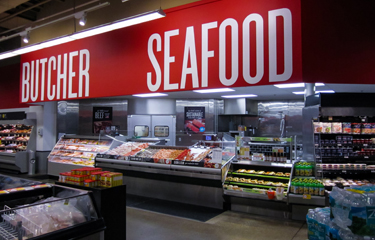U.S. retailers posted record seafood sales across the fresh, frozen, and shelf-stable categories, according to new data presented at the National Fisheries Institute’s Global Seafood Marketing Conference on 1 February.
Frozen seafood sales soared 35 percent to USD 7 billion (EUR 5.8 billion), fresh sales rose 24.5 percent to USD 6.7 billion (EUR 5.6 billion), and shelf-stable rose 20.3 percent to USD 2.9 billion (EUR 2.4 billion), according to 210 Analytics Principal Anne-Marie Roerink, citing data from IRI Worldwide.
A massive uptick in online grocery sales benefitted the category as well. Seafood e-commerce seafood sales tripled in 2020 to reach USD 1.1 billion (EUR 915.1 million) in 2020.
“This [seafood] category is on fire,” Roerink said.
In the frozen category, raw shrimp sales surged 48 percent to USD 2 billion (EUR 1.7 billion), and cooked shrimp sales soared 25 percent to USD 1.8 billion (EUR 1.5 billion).
Random weight fresh seafood sales – typically sold at the seafood counter – also saw impressive gains, with fresh finfish sales rising 22 percent, shellfish soaring 24.6 percent, and “all other” seafood sales rising 18 percent. Fresh fixed-weight seafood sales jumped 28 percent to USD 871 million (EUR 724.5 million).
The top 10 selling seafood species in the fresh department, in order, were: salmon, crab, shrimp, lobster, catfish, tilapia, cod, scallops, tuna, and trout.
Crab led the top five sales gainers in the category, followed by lobster, snapper, crab/seafood cakes, and halibut.
Roerink said fresh crab sales growth, which reached 62 percent in 2020, was “unheard of.” Salmon remained the powerhouse of the fresh seafood department, with a 19 percent increase in sales to USD 2.2 billon (EUR 1.8 billion) in 2020.
Tuna was the biggest seller in the shelf-stable category, with sales rising nearly 19 percent to USD 2.1 billion (EUR 1.7 billion). Shelf-stable salmon sales also soared 30.3 percent to USD 286 million (EUR 237.9 million), and clam sales jumped 27 percent to USD 62 million (EUR 51.6 million).
Despite last year’s eye-popping numbers representing banner year for seafood sales in the U.S., Roerink pointed out some points of concern she urged the industry to address.
Shelf-stable household penetration around 70 percent, and the average buyer spent nearly USD 33.00 (EUR 27.45) on shelf-stable seafood, according to the data. Baby Boomers were the biggest buyers of shelf-stable seafood, but Roerink said the industry was “lacking engagement” with millennials, Gen Z, and even some Gen Xers.
“How do we engage more with younger consumers?” she said.
Furthermore, frozen seafood sales skewed towards households with annual incomes above USD 100,000 (EUR 83,200). Roerink said the industry needs to do a better job encouraging lower-income households to buy more seafood.
Now that the seafood industry has attracted so many new consumers to the sector, Roerink said it is important to keep those shoppers engaged and encourage them to purchase additional seafood products.
“How can we get them to experiment more and try cooking seafood at home that they have never cooked before?” she said
IRI Senior Vice President of Protein Practice Chris DuBois said his firm predicts growth across all seafood categories will continue in 2021. But he said the industry shouldn’t rest on its laurels.
“Sales were so high in March and April – many weeks saw sales increases of 50 to 90 percent over 2019 – due to stock-ups and consumer panic, that we likely won’t see that level again,” DuBois told SeafoodSource. “As a result, companies might see comps versus 2020 down a lot even though they are selling a lot of more than in 2019.”
As the vaccination rate for COVID-19 rises and more Americans feel comfortable traveling and going out to eat, frozen seafood sales could drop off, DuBois cautioned.
“Frozen seafood was the biggest benefactor of [stay-at-home orders],” he said. “There is the risk that frozen seafood could decline. Finding a way to keep those buyers is going to be a big deal.”
IRI Worldwide also projects overall consumer product goods (CPG) sales to decline from 2020 by 2.3 percent though June. However, e-commerce sales will likely to continue to expand in the future, with IRI predicting double-digit growth in online seafood sales in 2021.
“You may see a drop at brick and mortar, but you will still see e-commerce growth,” DuBois said.
With such significant growth in such a short period of time, DuBois questioned whether retailers and food suppliers can keep up with the trend.
“Are you investing [in e-commerce] at the pace to drive the growth?” DuBois asked those in attendance at the virtual event.
As the past year showed, staying ahead of economic trends is vital, DuBois said. The overall pace of business has sped up, and seafood companies need to plan for a variety of scenarios both short-term and long-term, including the possibility of economic uncertainty if government stimulus funding declines or dries up later in 2021.
Photo courtesy of The Toidi/Shutterstock







